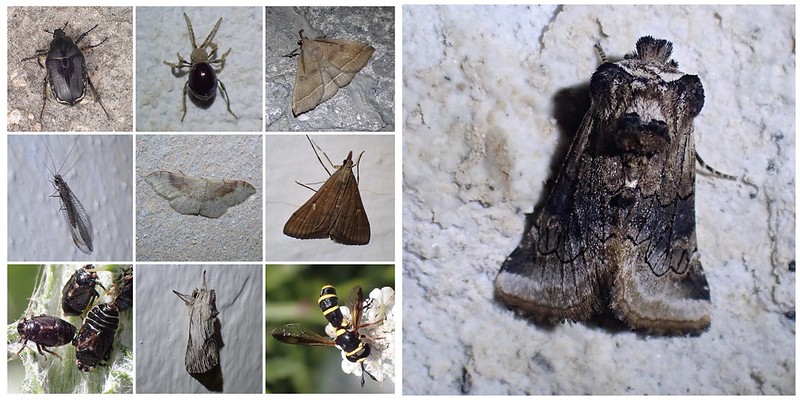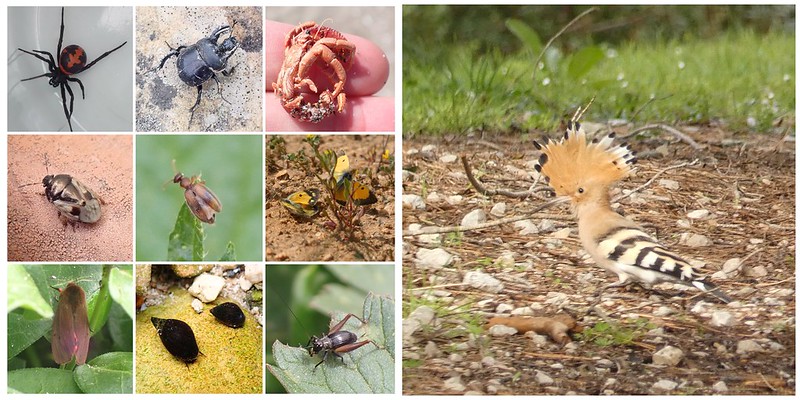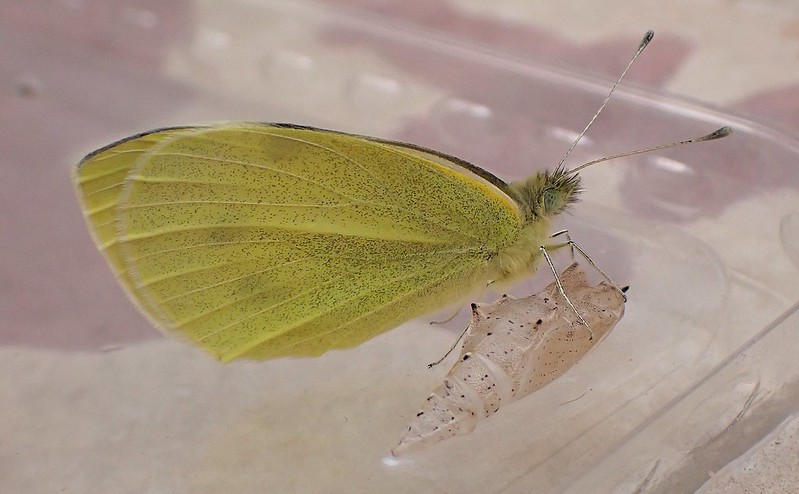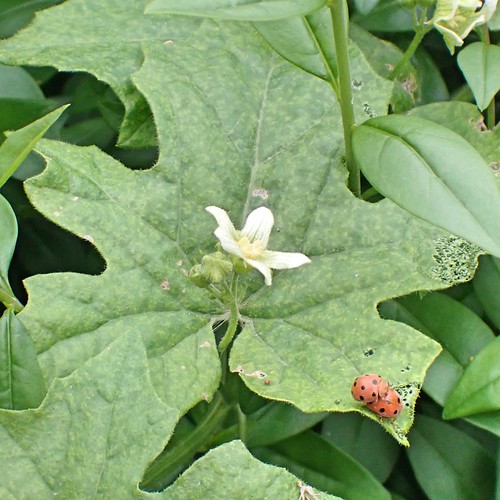iNat Year 2024 - goals and monthly recaps (-August)
So I have decided on this year's iNaturalist goals.
- First and foremost continue my streak which started on 30th Dec 2020. Since I don't work so much and I also don't have any international flights scheduled, it's just a matter of perseverance. If I don't find time during the day, I can always do my nightly moth-walk of about 1,5 h.
- Make a photo book at the end of the year. I started this in 2014 and it's growing into a nice collection. For that I should find at least 100 new-for-me animal species. Or at least 100 which haven't been featured in another book. Since the book of 2022 is about 2 months house-sitting in France (150 species) and 2023 about 3 weeks travelling the length of Germany (150 species, on which I am still working), there are quite a lot that don't yet appear in any book.
- I would really like to find 100 species of animals on thistles, from snails munching on the leaves, to butterflies and bees on the flowers, beetles laying eggs into the stems, finches eating the seeds, spiders building their web between the leaves etc. If I will be able to identify the species of thistle, that's enough botany for me.
SecretlyI am also counting the number of animal species seen in this year, since I didn't manage to find 1000 animals last year and only just made it over 1000 in total.
I just changed the order so that the new month is in the beginning.
By the way, if you are curious about my progress, you can see it here.
And if you want to help, these are the animal observations of this year that need ID.
August highlights

Another hot summer month that didn't make me feel like going on 15-km-hikes. So the photos of this month's lifers are from the immediate surroundings, from my nightly moth-walks and from snorkelling off the beaches of Málaga (and one from Almuñécar).
The first row is from nightly walks in Antequera. On the 12th I saw Hypotia corticalis (Pyralidae). On the very hot night of the 8th/ 9th, when it was still 30°C at midnight the tiger beetle Myriochila melancholica (Carabidae) was active. Though they are normally diurnal, they will apparently also come out on hot nights. They are not adapted to night life and don't see very well in the dark and so I could get closer to it than I would have during the day. The gold-banded etiella moth Etiella zinckenella (Pyralidae) is from the 7th. The elegantly striped bug Ragliodes delineatus (Rhypochromatidae) was found in the local pine forest on the 29th. The jewel beetle Dicerca aenea (Buprestidae) is from the 30th also from Antequera. Finally I managed to spot a new cricket Eumodicogryllus bordigalensis (Gryllidae) on the night of the 12/ 13th.
The last row shows sea-life.
The blenny Molly Miller (what a name! :-) ) Scartella cristata (Blenniidae) was seen on the 15th when I went with a bus tour to Almuñécar (province Granada) for a day on the beach and celebrating a local fiesta with a show of fireworks.
I found the cute tube hermit crab Calcinus tubularis (Diogenidae) on the 9th off Málaga. The last one in the row is actually the first lifer of the month from the 1st August, the comber Serranus cabrilla (Serranidae).
The next two lifers are the highlights of the month - or maybe the year!

The ant-lion Myrmeleon almohadarum (Myrmeleontidae) was only described in 2016 and my observation is the 3rd on iNat.
On the night walk of the 14th, actually on the 15th, two minutes after midnight I saw this cat sitting on a fence. It took me a while to realise that with this long ringed tail, it's not a cat, but a genet! Genetta genetta . And I saw it "en vivo y en directo" that is live and not run over and also not by trail cam but with my own eyes!
So, even the total tally until the end of August is only at 682 RG animals, it was quite an exciting month!
July highlights

Even though the overall species count was not high, I did manage to get my 10 lifers for the collage. On the 9th I went to the Sierra de Torremolinos (further down I will write a bit more about this excursion) and saw crested tits Lophophanes cristatus (Paridae). On the 28th I found two galls, which could be iDed. Tetraneura akinire was on Ulmus minor and is an aphid and the walnut blister mites Aceria erinea form galls on Juglans regia leaves.
The dead moth was found in Málaga after a day on the beach on the way to the bus station and still needs ID, but the ants were IDed as Paratrechina longicornis by the amazing identifiers @max_devis and @ard23 . The nice live moth is Nola infantula, (Nolidae) which was found on a moth-walk on the 27th. Also on a nightly walk I came across Dryadocoris apicalis (Pentatomidae). The following photos are from my weekly snorkelling-trips to a beach in Málaga. The edible crab Cancer pagurus (Cancridae) is actually not known to occur in the Mediterranean. I saw it on the 12th of July. The mediterranean fanworm Sabella spallanzanii (Sabellidae) was found on the 19th. The cute Caneva's blenny Microlipophrys canevae (Blenniidae) is from the 26th.
My favourite lifer of this month has to be the harlequin sea goddess Felimida binza (Chromodorididae), seen on the 19th.
Sharing the winner's podium with the sea slug is this beetle.

Ever since I found a dead beetle of this species seven years ago, I wanted to see a live one. So at least once a year I organise a trip to Torremolinos and hike through the mountains in the summer heat. For the 9th the weather report announced a temperature drop to only 25°C. So I took an early bus to Málaga and then the cercanias train to Torremolinos. In the mountains behind the town and the motorway grows the foodplant of the beetle, the joint pine Ephedra fragilis. The temperature was definitely more than 25°, but still supportable. I tried to stay in the shade of the pine trees and when I saw the crested tits I thought, well, at least the trip was not completely useless. I usually always encounter what I least expect. I did look at every joint pine though - and suddenly there was this couple of Buprestis sanguinea (Buprestidae) right on top! I am especially happy to have found male and female, because they look so different. What a day!
The overall RG animal species count for this year is at 631. Unfortunately special lifers don't count any more than say a cockroach.
June highlights

I have sorted the lifers of June into groups. The first row has new species of moths.
Epicallima mercedella (Oecophoridae) and Enolmis acanthella (Scythrididae) were found on my moth-walk of the 13th. Euchromius anapiellus (Crambidae) is from the 27th, also seen on the moth-walk in Antequera.
The beetles in the next row are Coptocephala scopulina (Chrysomelidae) from the 18th, Dermestes undulatus (Dermestidae) from the 15th and Anthaxia ignipennis (Buprestidae) from the 11th; all seen in and around Antequera.
Once a week I take the bus to Málaga city and go snorkelling at a beach. Since I am now in the third year, lifers become rarer. The axillary seabreams - Pagellus acarne (Sparidae) were observed on the 21st. I took the photo of the small periwinkle - Melarhaphe neritoides (Littorinidae) on the 29th, when the water was rather cold, so I mainly stayed very close to the shore and only up to my hips in the water. The next shell Euspira guilleminii (Naticidae) I found in about 1 m deep water on the 21st. It looked different, so I dived down to collect it. I was right, as it has only 10 observations on iNat. Then I realised it is inhabited. The hermit crab inside is the photo on the right. It was an iNatFirst, because the species Diogenes curvimanus (Diogenidae) was only separated from D. pugilator in 2021. I'm very grateful to @pierrenoel who identified it.
Two other species were not new, but they deserve a honorary mention.

On a long hike on the 18th I saw this mother red-legged partridge Alectoris rufa with more than 10 chicks.
The snorkelling-day of the 21st also brought me this marbled torpedo Torpedo marmorata (Torpedinidae), which fled in front of my feet in only knee-deep water. Two memorable experiences.
Mainly through the snorkelling I have managed to raise the number of RG-animals to 575.
May highlights

The animals in the grid on the left side are all lifers for me. I have changed the order a bit to make it more interesting looking. The micro-moth Cosmopterix pulchrimella (Cosmopterigidae) was found on the 4th in Antequera. On the night-walk of the 7th I saw the beetle Calosoma maderae (Carabidae). On the 12th I was very surprised to suddenly stand in front of this beautiful western black-eared wheatear Oenanthe hispanica (Muscicapidae) at the Torcal de Antequera. The night-walk of the 11th brought me an interesting fly Oxyaciura tibialis (Tephritidae). On the 24th I wanted to start my snorkeling-season, but the water was still rather cold. So I mainly stayed on the beach collecting some shells, like this Columbella rustica (Columbellidae). I was very excited to have found another tephrid fly on the 28th, similar but different: Aciura coryli (Tephritidae). It was sitting on an almond tree which was totally covered in honeydew. I saw a lot of interesting insects there, but most of them are not/ cannot be identified. On the 30th I photographed a colourful wasp, which could be identified as Ctenochares bicolorus (Ichneumonidae). The honeydew-tree brought me another cute little fly on the 25th: Trigonospila transvittata (Tachinidae). Finally I found a caterpillar on a fig-tree on the 30th, which turned out to be Choreutis nemorana (Choreutidae).
The insect on the right is not new, but belong to those that I have to see every year. It flies only for a few weeks in early summer, so I really made an effort to find it. It is the two-winged spoonwing Nemoptera bipennis (Nemopteridae).
I think I have by now covered a lot of the easy to find and/ or easy to identify species. Even though I saw a lot, the tally is (only) at 471 RG animal species.
April highlights

Those insects which could be titled "50 shades of grey" were all new for me in April. 7 of them I found during my nightly moth-walk, where I now have a fixed route with the best lit facades.
Aethiessa floralis (Scarabaeidae) was found in Fuente de Piedra on the 6th. During a moth-round on the 14th I spotted this tiny Shiny Spider Beetle Mezium affine (Ptinindae). The night of the 17th brought me this Plumed Fan-Foot Pechipogo plumigeralis (Erebidae). A lacewing that could be identified as Pseudomallada genei was found on the night of the 20th. On the 22nd I found a new member of the large genus of Idaea, the Portland Ribbon Wave Idaea degeneraria (Geometridae) and this Long-legged China-Mark Dolicharthria punctalis (Crambidae) (which I just realised is not new). On the next day I went to the local pine forest and saw the planthoppers Tettigometra impressifrons (Tettigometridae) on thistles! The night of the 26th brought me a "punkish" Antirhinum Brocade Calophasia platyptera (Noctuidae). On the 28th I went on a day-trip to Córdoba and included a bit of colour with this hoverfly Ceriana vespiformis (Syrphidae). The highlight of the month has to be the moth on the right, because it was not only new for me, but also an iNatFirst! Meanwhile there are two more observations by me and two by someone else, so it can't be that rare. Cleonymia pectinicornis (Noctuidae).
But I also have to show some nice birds.

The Whiskered Tern Chlidonias hybrida (Laridae) was seen in Fuente de Piedra. The next two photos show drakes trying to impress their females: White-headed Ducks Oxyura leucocephala from the Guadalhorce-mouth in Málaga and a pair of Marbled Ducks Marmaronetta angustirostris in Fuente de Piedra. The next two photos are herons - the Squacco Heron Ardeola ralloides is from Fuengirola and the Black-crowned Night Heron Nycticorax nycticorax from Córdoba. The woodchat shrike Lanius senator was seen in Málaga.
Spring started really slowly and we haven't reached "Spanish" temperatures yet. But I managed to reduce last month's backlog and am now at 388 RG animal species.
March highlights

Steatoda paykulliana (Theridiidae) is nothing new, but one of the nicest coloured and patterned individuals I have ever seen. I found it in Jimena de la Frontera in the kitchen sink and caught it in a cup. What a great start to the day! On the same day I found this Chelotrupes sp. (Geotrupidae), which has inspired me to start a project about "Beetles with horns". On the 15th I made a day trip to the coast, collected some shells and came across this dead hermit crab Dardanus arrosor (Diogenidae). The following day brought me two lifers in my patio Crocistethus waltlianus (Cydnidae) and Cordicomus instabilis (Anthicidae). On the next day I could observe this couple of the very common Colias croceus (Pieridae). You usually never see them with open wings, so for me the mating rejection was a really lucky occurrence! The last three pictures are lifers from a day trip to Loja (province Granada) on the 23rd. Phragmatobia fuliginosa (Erebidae), Melanopsis praemorsa (Melanopsidae) and Trigonidium cicindeloides (Trigonidiidae). The hoopoe Upupa epops (Upupidae) I observed for quite a while in Jimena de la Frontera, while it found some snacks on the floor. Then for just a moment, it raised its hood! Never seen before, I thought it had something to do with social behaviour but there was no one else. Maybe it was excited about the food or afraid about the vultures circling overhead - anyway a memorable experience!
The last week of March was characterised by more or less constant rain - very unusual for Andalusia and very unwelcome because it was Semana Santa and all processions had to be cancelled. I just managed to keep up my streak and achieved only 276 RG animal species until the 31st.
February highlights

Cassida deflorata (Chrysomelidae) as larva, pupa and adult - on thistle; Abrostola triplasia (Noctuidae) new for me in my hometown; on the 18th I went for a day trip to the Bay of Cádiz and saw Afruca tangeri West African Fiddler Crabs - they only occur on the Atlantic coast from West Africa to the Algarve; as well as Numenius arquata (Scolopacidae) and Phoenicopterus roseus (Phoenicopteridae), not new, but I don't often get a photo in flight. From 29.2. to 3.3. I stayed with a friend in Jimena de la Frontera (Cádiz province). On the first night I did a moth-walk and found this new Horisme scorteata (Geometridae). The Red-legged Partridge Alectoris rufa is also from the Bay of Cádiz.
The number of RG animal species until the end of February is 196.
January highlights
Perigune narbonea (Geometridae); gall of wasp Andricus quercustozae (Cynipidae); Cisticola juncidis (Cisticolidae) is not new, but I think a really cute photo; of Dicranopalpus caudatus (Phalangiidae)I have to show two photos, because I find the forked pedipalps really fascinating; Conostethus venustus (Miridae) on thistle :-); Deroceras reticulatum (Agriolimacidae); Menemerus taeniatus (Salticidae); Chesias rufata (Geometridae). All of those species I found walking around Antequera. The wigeon Mareca penelope (Anatidae) I spotted on a day trip to the Guadalhorce-mouth in Málaga. This day and another trip to Fuente de Piedra provided all of the usual avian suspects (except cranes) and this new duck.
The number of RG animals species for January is 103.











